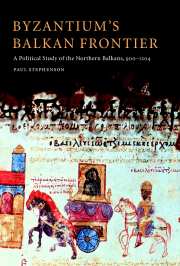Book contents
- Frontmatter
- Contents
- List of maps and figures
- Preface
- A note on citation and transliteration
- List of abbreviations
- Introduction
- 1 Bulgaria and beyond: the Northern Balkans (c.900–963)
- 2 The Byzantine occupation of Bulgaria (963–1025)
- 3 Northern nomads (1025–1100)
- 4 Southern Slavs (1025–1100)
- 5 The rise of the west, I: Normans and Crusaders (1081–1118)
- 6 The rise of the west, II: Hungarians and Venetians (1100–1143)
- 7 Manuel I Comnenus confronts the West (1143–1156)
- 8 Advancing the frontier: the annexation of Sirmium and Dalmatia (1156–1180)
- 9 Casting off the ‘Byzantine Yoke’ (1180–1204)
- Conclusions
- Bibliography
- Index
9 - Casting off the ‘Byzantine Yoke’ (1180–1204)
Published online by Cambridge University Press: 25 August 2009
- Frontmatter
- Contents
- List of maps and figures
- Preface
- A note on citation and transliteration
- List of abbreviations
- Introduction
- 1 Bulgaria and beyond: the Northern Balkans (c.900–963)
- 2 The Byzantine occupation of Bulgaria (963–1025)
- 3 Northern nomads (1025–1100)
- 4 Southern Slavs (1025–1100)
- 5 The rise of the west, I: Normans and Crusaders (1081–1118)
- 6 The rise of the west, II: Hungarians and Venetians (1100–1143)
- 7 Manuel I Comnenus confronts the West (1143–1156)
- 8 Advancing the frontier: the annexation of Sirmium and Dalmatia (1156–1180)
- 9 Casting off the ‘Byzantine Yoke’ (1180–1204)
- Conclusions
- Bibliography
- Index
Summary
The period from the death of Manuel I Comnenus in 1180 to the cataclysmic sack of Constantinople by the forces of the Fourth Crusade in 1204 has attracted much comment from, but far less careful analysis by, Byzantine historians. As Michael Angold (1997: 173) recently noted, we have merely asked the same question to which Charles Brand offered a convincing answer in 1968: was the fall of Constantinople just an accident or did the Byzantines bring it on themselves? More recently a second question, initially posed by Nicetas Choniates soon after 1204, has been asked again by Paul Magdalino: can the origins of decline be traced to the reign of Manuel Comnenus? Angold prefers Choniates' positive over Magdalino's negative response:
The expansion of the west presented Manuel Comnenus with problems that he dealt with ingeniously, but it involved him in an increasingly grandiose foreign policy. There is no doubt that he conducted it with skill and aplomb, but it was hugely expensive and the returns were limited. It placed all kinds of strains on his empire. His rapprochement with the west produced an anti-Latin backlash that added to the dificulties facing his successors. The financial costs were enormous … Manuel Comnenus’ reign … saw both the apogee of the Comnenian achievement and the beginning of its decline.
(Angold 1997: 180)Angold sees great similarities between Manuel's reign and that of Basil II, who similarly left his successors a poisoned legacy.
- Type
- Chapter
- Information
- Byzantium's Balkan FrontierA Political Study of the Northern Balkans, 900–1204, pp. 275 - 315Publisher: Cambridge University PressPrint publication year: 2000



